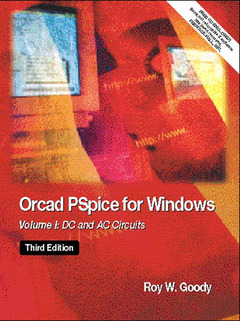OrCAD PSpice for Windows, Volume 1: DC & AC circuits, 3rd ed.
Langue : Anglais
Auteur : GOODY Roy

- For courses in DC/AC Principles, Devices and Circuits, Operational Amplifiers, and Digital, Analog, and Filter Design.
This text series takes students from a simple DC circuit with its customary current and voltage measurements, through a damped resonant circuit requiring rise time characteristics, to a complex digital circuit that demands sophisticated timing and frequency measurements. It continues simulation studies with more advanced topics such as operational amplifiers, digital, and filter design. Comfortable, yet challenging, multi-level activities, examples, and exercises show students how to use the program to draw circuits directly on the screen, analyze the circuit in seconds using PSpice, and display the results using sophisticated techniques that go far beyond those possible with conventional instruments.
- VOLUME I.
I. DC CIRCUITS.
1. Introduction to Capture- Ohms law and Bias Point Analysis.
2. Series/Parallel DC Circuits- Multiple Schematics.
3. Voltage Source Theorems- Thevenins, Mesh, and Superposition.
4. Current Source Theorems- Nortons, Nodal, and Superposition.
5. The DC Sweep Mode- Linearity and Markers.
6. DC Sweep Options- Power Transfer.
II. AC Circuits.
7. AC Resistance- The Transient Mode.
8. AC Inductance- Transformers.
9. AC Capacitance- Troubleshooting Circuits.
10. RLC Circuits-Impedance.
11. Power and Energy- Power Factor.
12. The Frequency Domain- The AC Sweep Mode.
13. Complex Numbers- Rectangular and Polar.
14. Series Resonance- An Analog Computer.
15. Parametric mode- Family of Curves.
16. RC Time Constant- Rise Time.
17. Filters- Multiple Output Screens.
III. SPECIAL PROCESSES.
18. Device Models- Temperature Coefficient.
19. Harmonic Distortion- Fourier Analysis.
Appendix A: Simulation Notes Summary.
Appendix B: Axis and Grid Control.
Appendix C: Data Sheets.
Index.
VOLUME II
I. DIODE CIRCUITS.
1. The Diode- Switching Speed.
2. The Zener Diode- Voltage Regulation.
3. The Power Supply- AC to DC.
4. Clippers, Clampers, &, Multipliers- Component Initialization.
5. The Analog Switch- Crash Studies.
II. BIPOLAR TRANSISTOR CIRCUITS.
6. The Bipolar Transisto- Collector Curves.
7. Bipolar Biasing- Temperature Stability.
8. Bipolar Amplifier- Equivalent Circuits.
9. Bipolar Buffer- Frequency-Domain Analysis.
10. Amplifier Power- Class A Operation.
11. Amplifier Efficiency- Class B and C.
III. FIELD-EFFECT TRANSISTOR CIRCUITS.
12. The Field Effect-Transistor- Drain Curves.
13. The E-MOSFET- CMOS.
14. FET Biasing- Temperature Stability.
15. FET Amplifiers and Buffers- Input Impedance.
IV. SPECIAL SOLID STATE STUDIES.
16. The Transistor Switch- Frequency of Operation.
17. Thyristor- The Silicon-Control Rectifier.
V. THE OPERATIONAL AMPLIFIER.
18. The Differential Amplifier- Common-mode Rejection.
19. Negative Feedback- Open Loop versus Closed Loop.
20. The Operational Amplifier- Specifications.
21. The Non-Inverting Configuration- VCVS and VCIS.
22. The Inverting Configuration- ICVS and ICIS.
23. Op Amp Integrator/Differentiator- Calculus.
24. Oscillators- Positive Feedback.
25. Filters- Passive and Active.
26. The Instrumentation Amplifier- Precision CMRR.
VI. SPECIAL PROCESSES.
27. Noise Analysis- Signal-to-Noise Ratio.
28. Monte Carlo Analysis- Tolerances.
29. Worst Case Analysis- AC Sensitivity.
30. Performance Analysis- Goal Functions.
31. The Histogram- Gaussian Distribution.
32. Analog Behavioral Modeling- Controlled Sources.
Appendix A: Simulation Note Summary.
Appendix B: Axis and Grid Control.
Appendix C: Specification Sheets.
Index.
VOLUME III.
I. GATES AND FLIP-FLOPS.
1. TTL Logic Gates- Analog/Digital Interfaces.
2. Digital Stimulus- File Stimulus.
3. Latches and Flip-Flops- Edge- Versus Level-Triggered.
II. VIOLATIONS AND HAZARDS.
4. Ambiguity Hazards- Digital Worst Case Analysis.
5. Timing Hazards- Setup, Hold, and Width.
6. Critical Hazards- Persistence.
III. COUNTERS, CODERS, AND TIMERS.
7. Counters- Synchronous Versus Asynchronous.
8. Shift Registers- Discrete Versus Integrated.
9. Digital Coding- Comparators, Coders, and Multiplexers.
10. The 555 Timer- Multivibrator Operation.
IV. CONVERTERS AND RAM.
11. Analog/Digital Conversions- Resolution.
12. Random-Access Memory- Data Acquisition.
V. DATA COMMUNICATIONS.
13. Amplitude Modulation- Detection.
14. The Phase-Locked-Loop- The Phase Comparator.
VI. MODULAR DESIGN AND APPLICATIONS.
15. Modular Designs- Hierarchy.
16. Touch-Tone Decoding- The Bandpass Filter.
17. Pulse-Code Modulation- Time-Division Multiplexing.
Appendix: Simulation Notes Sum
- NEW - Based on Cadence/OrCAD PSpice version 9.1 - The latest of the most popular simulation software presently available.
- NEW - Eight added DC/AC chapters in Volume I.
- Reflects the increasing numbers of teachers and students who wish to introduce circuit stimulation at an earlier state, and have access to computers in their early DC/AC courses. - NEW - Reorganized content-Moves section on operational amplifiers from Vol. III to Vol. II.
- Assembles the material in a logical way for students, by associating operational amplifiers with analog devices and circuits-as they are primarily part of these systems rather than digital. - A wide range of electronic theory.
- Compliments all the major PSpice techniques and processes. - 'Hands-on' experiments.
-
Date de parution : 09-2000
Ouvrage de 306 p.
26.7x20.3 cm
© 2024 LAVOISIER S.A.S.



